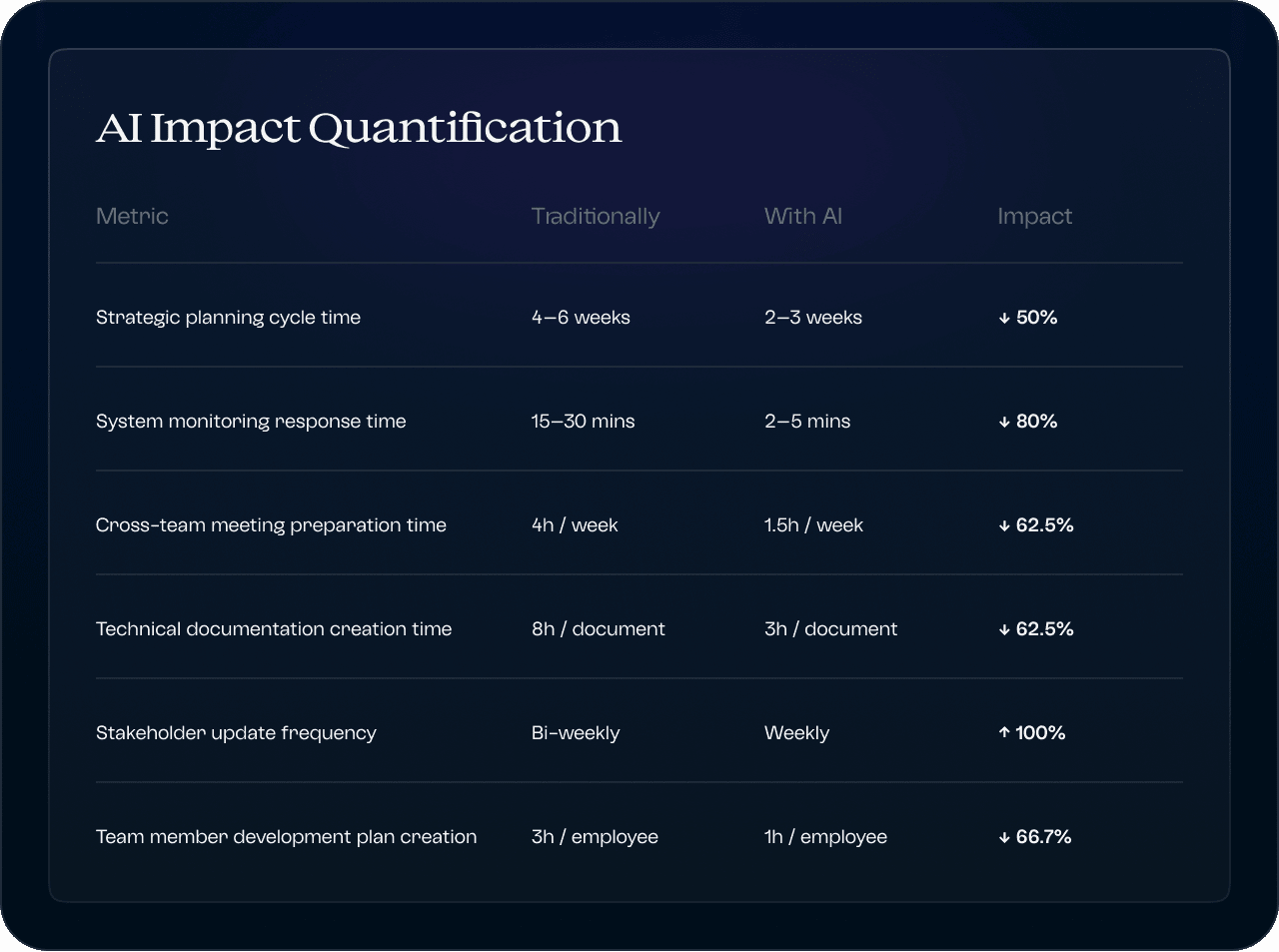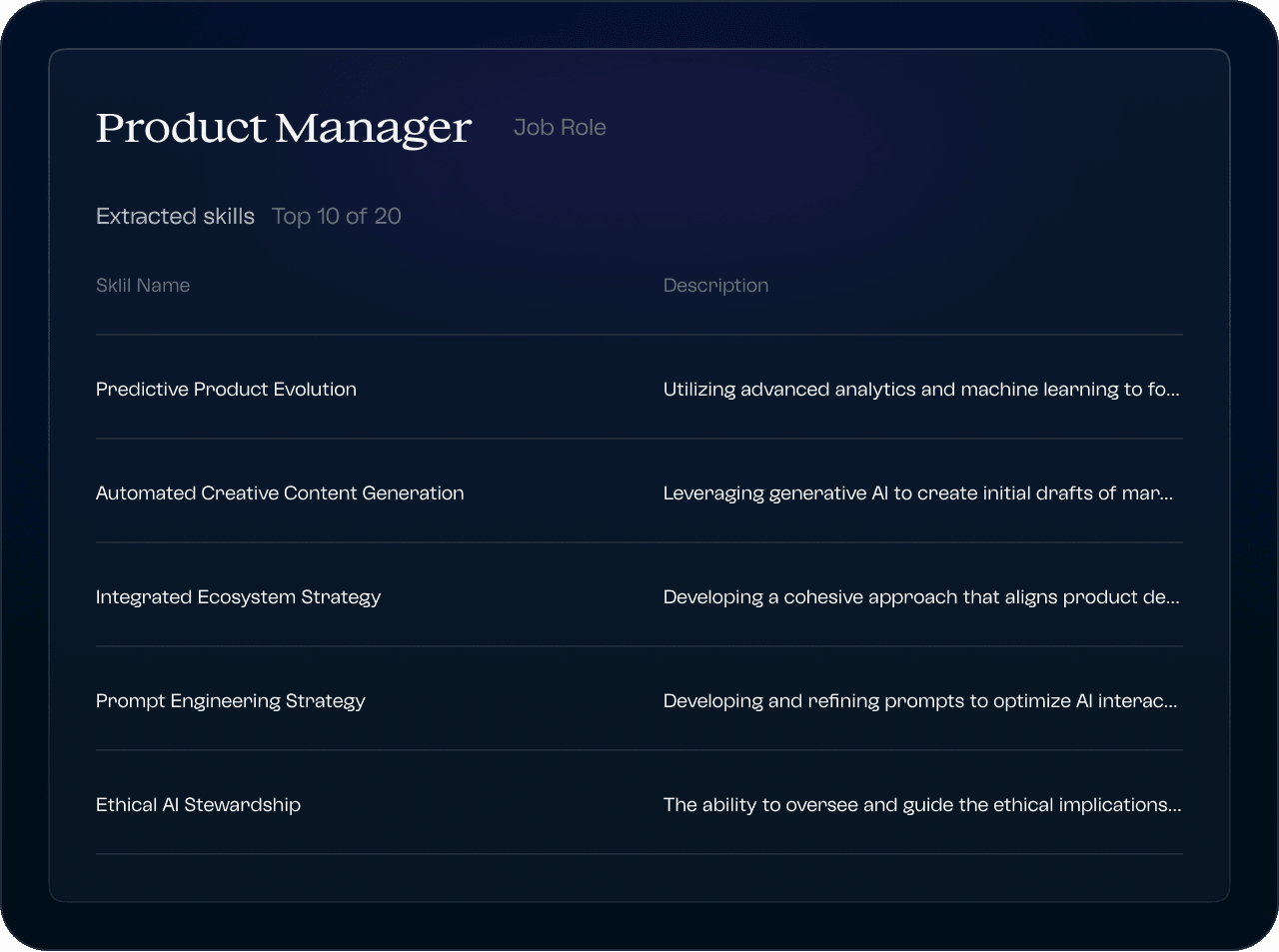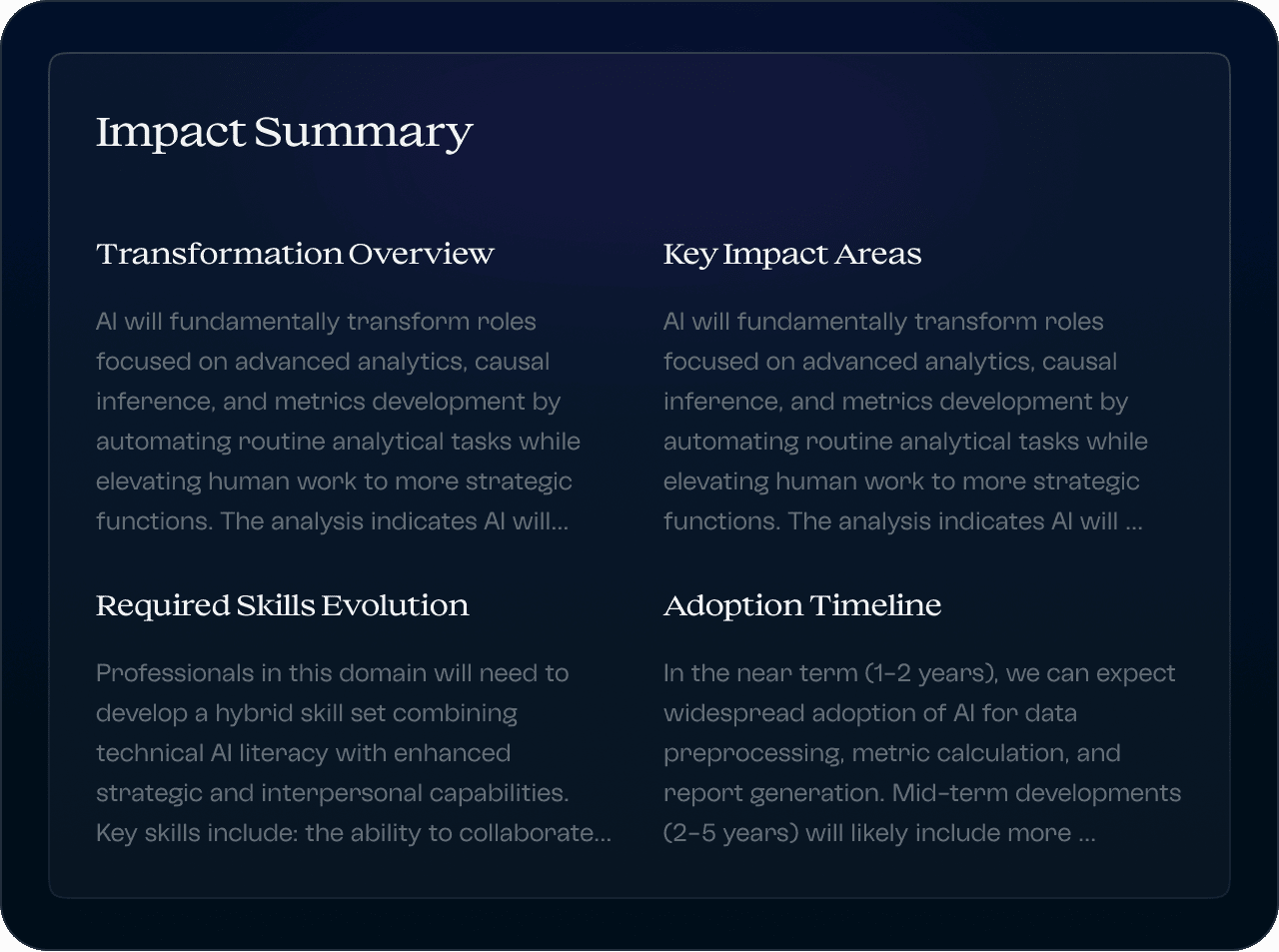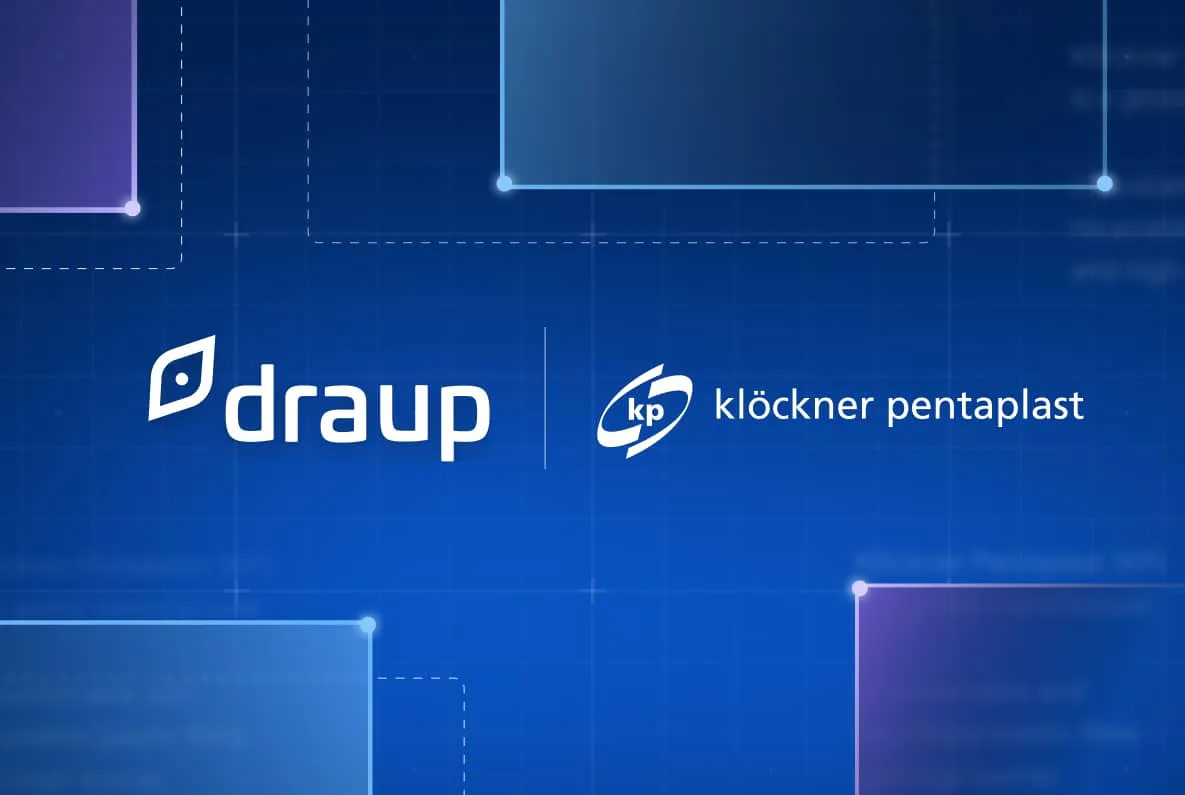AI Is Changing How Work Gets Done. Etter Shows You How to Adapt.
Work Redesign
Instantly model how tasks change, which skills matter next, and what roles should look like in an AI-led organization
By filling up this form, you agree to allow Draup to share this data with our affiliates, subsidiaries and third parties


























Every job is changing with AI. Some tasks will disappear, some will be automated, and some will grow in importance.
Etter helps you see this clearly, quantify it, and act with confidence.
Assessing AI impact at every level
Company-Wide
Holistic workforce AI impact on capacity and spend
Business Unit
Functions most affected by automation
Function
Task-level breakdown (Finance, HR, Insurance Ops, Sales)
Role
% of tasks automated, heads redeployed, $ savings quantified
A lens into the future of work
Assess AI Impact
Identify Impacted Role by AI
Focus on Human Tasks
Automate Tasks for Automation
Extract Tasks from Maps
Create AI-Transformed JDs
Analyzes every task, and classifies as Human, AI, or Human+AI
Builds AI-ready job descriptions & skills frameworks at scale
Find where can we gain productivity and where are humans essential
Etter: The AI Transformation Engine for Enterprises
The 3 pillars of Etter

Draup Models
Role Disruption Index
To assess which job roles are at highest risk or opportunity due to AI
Workload Disaggregation Models
To split job descriptions into automatable, augmentable, and human-centric tasks
Skills Evolution Models
To detect emerging, sustaining, and declining skills forany function or industry
Hiring Difficulty and Talent Density Models
To evaluate strategic feasibility ofworkforce shifts.

Agentic Workflows
- Designed to simulate and recommend action paths such as reskilling plans, role reconfiguration, and center-of-excellence creation.
- These workflows are adaptive, meaning they can tailor decisions based on new inputs
- Enterprise-specific overlays enable alignment with internal org structures, performance metrics, and cost frameworks

Sustainability Engine
- Ensures long-term workforce transformation by embedding fairness, inclusion, and retention metrics in every recommendation.
- Offers real-time dashboards that track transformation maturity across business units and geographies.
- Enables scenario planning for balancing short-term automation gains with long-term talent resilience.
Understand AI's Impact on Every Role
See how AI will reshape tasks and workloads across your organization
- Break tasks into "Fully AI," "Fully Human," or "Human + AI" categories using Etter’s Task Analysis model.
- Highlight time-savings, productivity gains, and risks for each role.

Plan the Skills Your Teams Will Need Next
Equip your workforce with the skills to succeed in an AI-powered future.
- Map future-ready skills and build balanced AI-centric teams with the Role Ecosystem Model.
- Identify similar roles to foster mobility and prepare for AI-driven transitions.

Write AI-Optimized Job Descriptions
Attract the right talent with job descriptions built for the future of work.
- Transform job descriptions with AI-specific skills and tools using the AI-Ready JD Model.
- Ensure inclusivity and alignment with organizational goals.

Build a Custom AI Transformation Roadmap
Navigate AI integration with a clear, actionable plan tailored to your organization.
- Pinpoint roles most impacted by AI and tailor geo-specific strategies with Location Insights.
- Create an actionable step-by-step workforce transformation plan.

The impact of Etter
AI adoption is outpacing HR transformation cycles – risk of 18–24 month lag
.svg)
HR must lead in workforce transformation

Delays risk productivity loss, inefficient investments, and skills misalignment




25–30% of routine tasks across all functions can be automated → freeing capacity and savings
.svg)
Scenario modeling shows >$20 Billion potential workforce ROI over 3–4 years
.svg)
Faster job and skills updates save HR thousands of hours annually
.svg)
Reduces skill misalignment by 25%+ through dynamic architecture

The models of Etter
Workload Intelligence Model

Decompose roles, classify execution modes, and map effort to outcomes
Break roles into clear workload categories and tag by functional type and BU relevance.
Break roles into clear workload categories and tag by functional type and BU relevance.
Classify each workload as Automatable, AI-Augmentable, or Human-Centric
Apply time models and link to enterprise productivity data to validate assumptions.
Determine what work is being done, how it’s executed today, and how it should evolve with AI, creating a defensible foundation for redesign
Task Analysis Model

Move from narrative job descriptions to a task-level map you can redesign
Break roles into granular tasks and classify each by automation or augmentation potential.
Convert structured and unstructured job descriptions into discrete tasks.
Tag tasks as fully automatable, partially automatable, or human-exclusive.
Measure workload distribution across task types and align with functional expectations.
A task-level map with workload percentage breakdowns and automation-readiness flags to guide augmentation, reskilling, or redesign.
Peer Tech Stack Mapping Model

Decompose roles, classify execution modes, and map effort to outcomes
Align tasks and job responsibilities to current and emerging technologies relevant for execution.
Link job functions to AI tools, platforms, and APIs
Assess technology maturity and integration difficulty within existing enterprise workflows.
Consider both enterprise-grade solutions and open-source alternatives.
A tech roadmap per role with recommended interventions and a difficulty index, useful for digital enablement planning.
AI Impact Model

Compare pre-AI vs. AI-integrated execution and quantify gains.
Quantify how roles evolve from traditional to AI-augmented functions.
Current (pre-AI) vs.future (AI-integrated) task structures.
Time savings (%), productivity uplift, redundancy risk.
A comparative AI impact dashboard showing where to invest in augmentation, automation, or upskilling.
AI-Ready JD Model

Produce versioned, annotated JDs, ready for internal or external systems.
Convert legacy job descriptions into future-ready, AI-enhanced role profiles.
(e.g., leveraging LLMs where relevant).
emphasize digital fluency, adaptability, and cross-functional collaboration.
for every edit, to ensure compliance, clarity, and hiring-manager buy-in.
Versioned, annotated, AI-ready JD, publishable to internal or external talent systems.
Location Insights Model

Tie AI talent deployment to the realities of each market
Understand how location influences AI talent deployment and workforce configuration.
Compensation benchmarks, local AI talent availability, cost of living & benefit norms, remote/hybrid feasibility.
Local regulatory and DEI considerations.
A location-optimized workforce strategy with recommendations to adjust job constructs across geographies.
Similar Role Model

Use role graphs to detect adjacencies and unlock internal mobility.
Identify analogous/adjacent roles for workforce redeployment and AI-driven mobility planning.
to detect natural role adjacencies.
highlight moves based on shared core and emerging skills.
to reach the target AI-ready role.
A role similarity & transition framework to fuel internal mobility, reduce redundancy risk, and unlock adjacent talent pools.
Role Ecosystem Model

Evaluate interdependencies, recommend new/redesigned roles, align tasks and tools.
Design a future-fit, AI-augmented ecosystem of roles across a team, department, or function.
Evaluate role interdependencies and ensure complementary skill profiles.
Recommend new roles and redesigned roles
Align task structures and shared tools to enable team-level AI leverage.
An AI role ecosystem blueprint with job constructs reflecting balance, interconnectivity, and tech leverage.
Job Role to Metrics Model

Convert qualitative JDs into structured, comparable indicators
Turn JDs into benchmarkable, comparable role KPIs.
to detect natural role adjacencies.
- Decompose each JD into core tasks &responsibilities.
- Translate to metrics using role-specific standards, benchmarking studies, and domain research.
- Ensure metrics are evidence-based, role-specific, and comparable across peers and industries.
- Create a consistent, defensible model for ROI analysis, AI impact measurement, and performance tracking.
- Clear baselines for where each role stands today.
- Measurable impact projections showing how AI/process changes shift metrics.
- Benchmark alignment tied to recognized industry sources for credibility.
- Scalability to replicate across every role.

The Engine Behind Enterprise Workforce Transformation
from design to deployment










.svg)




























.svg)





.svg)
